warning lights Oldsmobile Achieva 1998 Owner's Manuals
[x] Cancel search | Manufacturer: OLDSMOBILE, Model Year: 1998, Model line: Achieva, Model: Oldsmobile Achieva 1998Pages: 356, PDF Size: 18.04 MB
Page 7 of 356

Vehicle Symbols
These are some of the symbols you may find on your vehicle.
For example,
these symbols are used on an
original battery:
POSSIBLE A
CAUTION
INJURY
PROTECT EYES BY
SHIELDING
CAUSTIC
BATTERY
CAUSE
BURNS
ACID COULD
&
AVOID
SPARKS
OR
FLAMES
SPARK
OR ,\I/,
COULD FLAME
EXPLODE BATTERY
These symbols are important
for you and
your passengers
whenever your
vehicle is
driven:
DOOR LOCK
UNLOCK
FASTEN SEAT
BELTS
POWER
WINDOW
These symbols have to
do with
your lamps:
SIGNALS e
TURN
PAEJN&
pf
WARNING A
HAZARD
FLASHER
RUNNING
.‘:**o
DAYTIME LAMPS
***
FOG LAMPS # 0
These symbols are. on some
of
your controls:
WINDSHIELD
WIPER
WINDSHIELD DEFROSTER
WINDOW
DEFOGGER
VENTILATING FAN
These symbols are used on
warning and
indicator lights:
COOLANT F-
TEMP -
CHARGING BAllERY
SYSTEM
BRAKE
(a)
COOLANT
ENGINE OIL
PRESSURE
Wb
ANTI-LOCK (@)
BRAKES
Here are some
other symbols
you may see:
FUSE
I
LIGHTER
HORN
)b.
SPEAKER
b
FUEL p3
V
Page 65 of 356

Section 2 2s and COI :- 11s
Here you can learn about the many standard and optional features on your vehicle, and information on starting,
shifting and braking. Also explained
are the instrument panel and the warning systems that tell you if everything is
working properly
-- and what to do if you have a problem.
2-2
2-4
2-6 2-10
2-11
2- 12
2-13
2-13
2- 14
2-
17
2-18
2-23
2-24 2-26 Keys
Door Locks
Remote
Lock Control
(If Equipped)
Trunk
Theft
Passlock@
New Vehicle “Break-In”
Ignition Positions”
Starting Your Engine
Engine Coolant Heater (If Equipped)
Automatic Transaxle Operation
Parking Brake
Shifting Into PARK (P)
Shifting Out of PARK (P) 2-26
2-27
2-27
2-28
2-29 2-29
2-30
2-37
2-39
2-42
2-43 2-45
2-46
2-50 Parking Over
Things That
Burn
Engine Exhaust
Running Your Engine While You’re Parked
Windows
Horn
Tilt Wheel
Turn Signal/Multifunction Lever
Exterior Lamps
Interior Lamps
Mirrors Storage Compartments
Accessory Power Outlet
Instrument Panel
Warning Lights, Gages and Indicators
2-1
Page 78 of 356
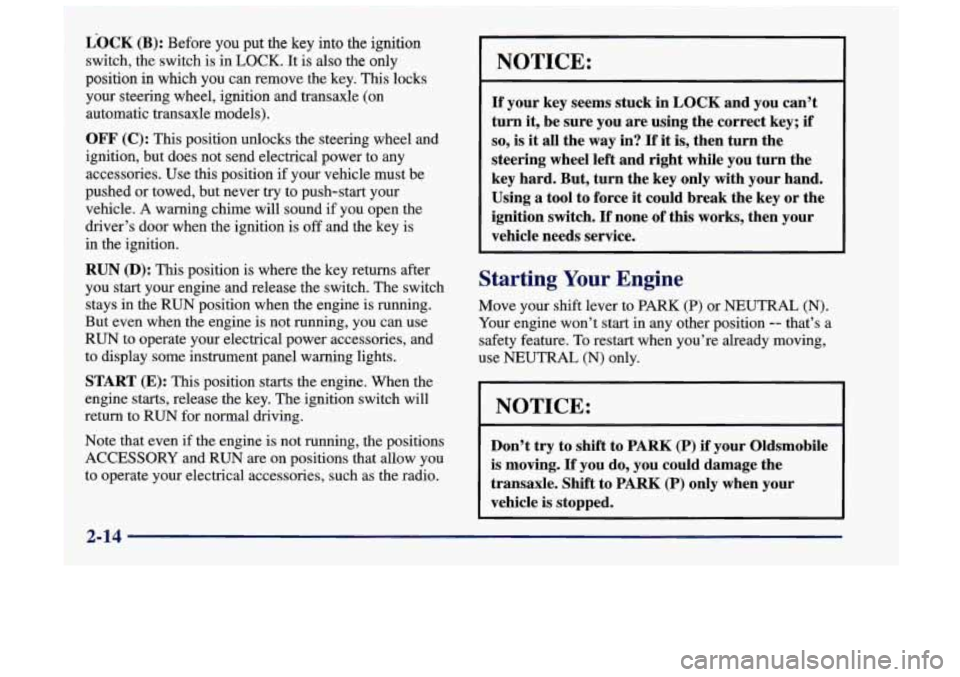
L-OCK (B): Before you put the key into the ignition
switch, the switch
is in LOCK. It is also the only
position in which you can remove the key.
This locks
your steering wheel, ignition and transaxle
(on
automatic transaxle models).
OFF (C): This position unlocks the steering wheel and
ignition, but does not send electrical power to any
accessories. Use this position if your vehicle must be
pushed or towed, but never try to push-start your
vehicle. A warning chime will sound if you open the
driver’s door when the ignition is off and the key is
in the ignition.
RUN (D): This position is where the key returns after
you start your engine and release the switch. The switch
stays in the RUN position when the engine is running.
But even when the engine is not running, you can use
RUN to operate your electrical power accessories, and
to display some instrument panel warning lights.
START (E): This position starts the engine. When the
engine starts, release the key. The ignition switch will
return to
RUN for normal driving.
Note that even
if the engine is not running, the positions
ACCESSORY and RUN are on positions that allow you
to operate your electrical accessories, such as the radio.
NOTICE:
If your key seems stuck in LOCK and you can’t
turn it, be sure you are using the correct key; if
so, is it all the way in? If it is, then turn the
steering wheel left and right while you turn the
key hard. But, turn the key only with your hand.
Using
a tool to force it could break the key or the
ignition switch.
If none of this works, then your
vehicle needs service.
Starting Your Engine
Move your shift lever to PARK (P) or NEUTRAL (N).
Your engine won’t start in any other position
-- that’s a
safety feature.
To restart when you’re already moving,
use NEUTRAL (N) only.
NOTICE:
Don’t try to shift to PARK (P) if your Oldsmobile
is moving. If you do, you could damage the
transaxle. Shift to
PARK (P) only when your
vehicle is stopped.
2-14
Page 102 of 356
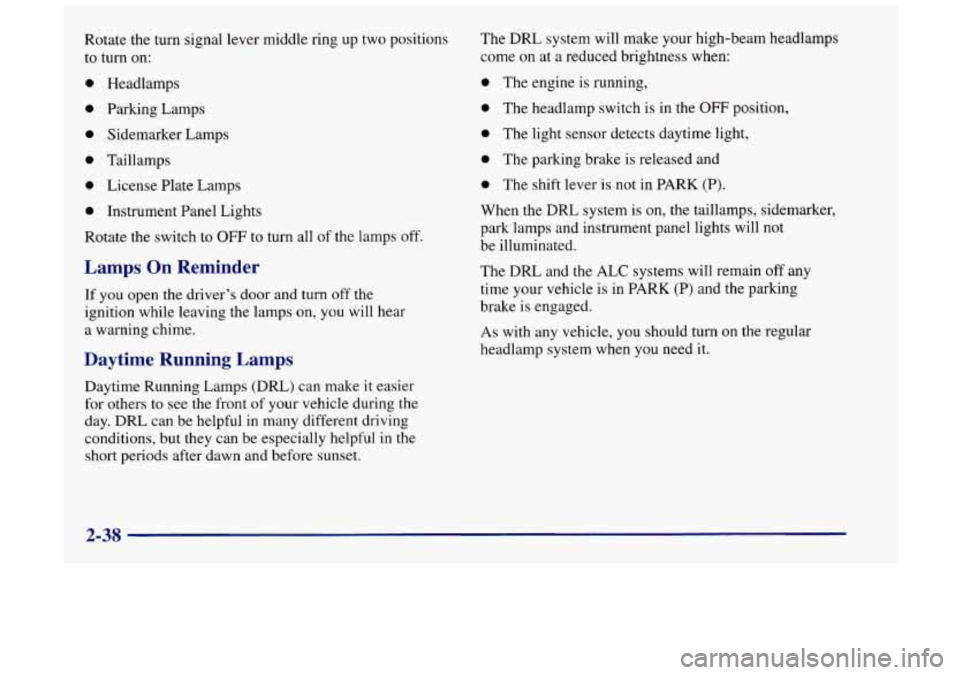
Rotate the turn signal lever middle ring up two positions
to turn on: The
DRL system
will make your high-beam neadlamps
come
on at a reduced brightness when:
0 Headlamps
0 Parking Lamps
0 Sidemarker Lamps
0 Taillamps
0 License Plate Lamps
0 Instrument Panel Lights
Rotate the switch to
OFF to turn all of the lamps off.
Lamps On Reminder
If you open the driver’s door and turn off the
ignition while leaving the lamps on, you will hear
a warning chime.
Daytime Running Lamps
Daytime Running Lamps (DRL) can make it easier
for others to see the front
of your vehicle during the
day. DRL can be helpful in many different driving
conditions, but they can be especially helpful in the
short periods after dawn and before sunset.
0 The engine is running,
0 The headlamp switch is in the OFF position,
0 The light sensor detects daytime light,
0 The parking brake is released and
0 The shift lever is not in PARK (P).
When the DRL system is on, the taillamps, sidemarker,
park lamps and instrument panel lights will not
be illuminated.
The
DRL and the ALC systems will remain off any
time your vehicle is in
PARK (P) and the parking
brake is engaged.
As with any vehicle, you should turn on the regular
headlamp system when you need it.
2-38
Page 112 of 356
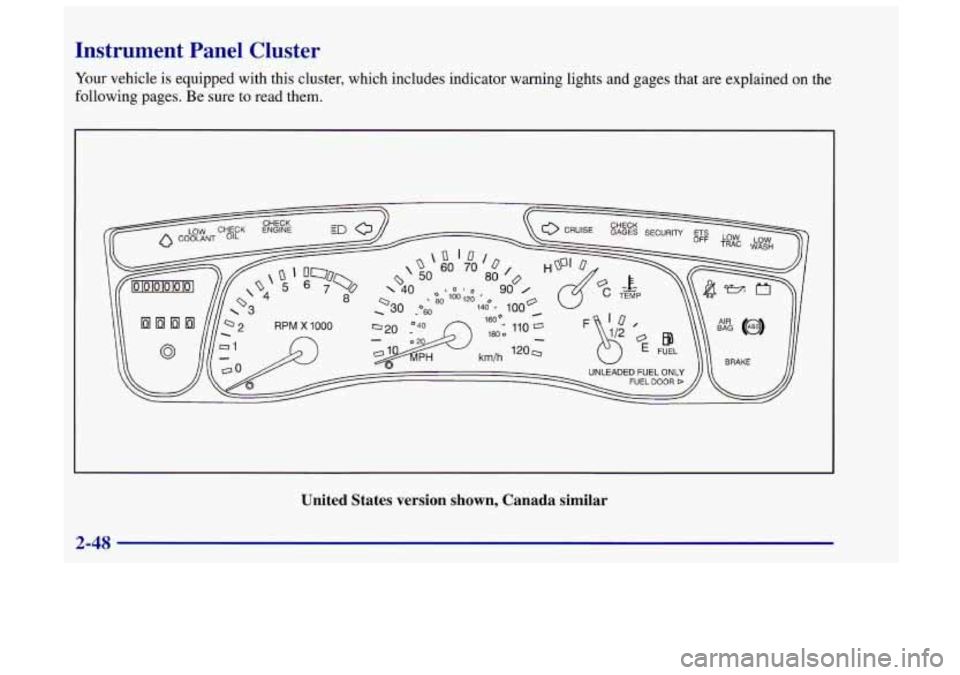
Instrument Panel Cluster
Your vehicle is equipped with this cluster, which includes indicator warning lights and gages that are explained on the
following pages. Be sure to read them.
United States version shown, Canada similar
Page 114 of 356
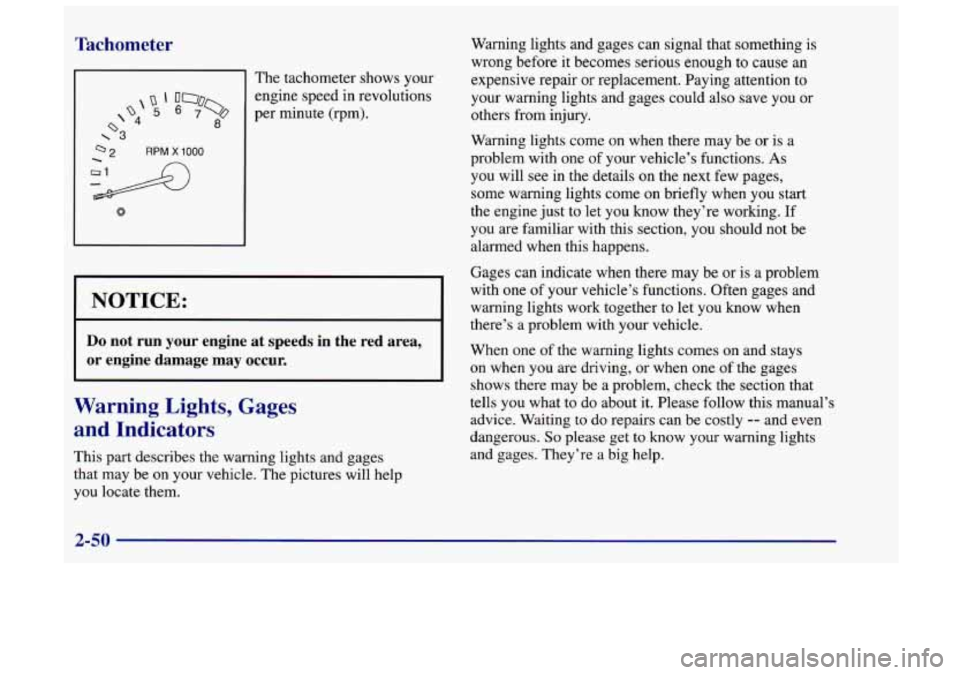
Tachometer
The tachometer shows your
Q 1 OQI engine speed in revolutions
9 5 6 7 c’o per minute (rpm). d 8 \3
RPM X 1000
0
I
NOTICE: - - ~~~ ~
Do not run your engine at speeds in the red area,
or engine damage may
occur.
Warning Lights, Gages
and Indicators
This part describes the warning lights and gages
that may be on your vehicle. The pictures will help
you locate them. Warning
lights and gages can signal that something
is
wrong before it becomes serious enough to cause an
expensive repair
or replacement. Paying attention to
your warning lights and gages could also save you or
others from injury.
Warning lights come on when there may be or
is a
problem with one of your vehicle’s functions.
As
you will see in the details on the next few pages,
some warning lights come
on briefly when you start
the engine just to
let you know they’re working. If
you are familiar with this section, you should not be
alarmed when this happens.
Gages can indicate when there may be or is a problem
with one of your vehicle’s functions. Often gages and
warning lights work together
to let you know when
there’s a problem with your vehicle.
When one
of the warning lights comes on and stays
on when you are driving, or when one
of the gages
shows there may be a problem, check the section that
tells you what to do about it. Please follow this manual’s
advice. Waiting to do repairs can be costly
-- and even
dangerous.
So please get to know your warning lights
and gages. They’re a big help.
2-50
Page 190 of 356

Hazard Warning Flashers
Your hazard warning flashers let you warn others. They
also let police know you have a problem. Your front and
rear turn signal lamps will flash
on and off.
Move the switch to the right
to make your front and rear
turn signal lights flash
on
and off.
Your hazard warning flashers work no matter what
position your key is in, and even if the key isn’t in.
To turn off the flashers, move the switch to the left.
When the hazard warning flashers are
on, your turn
signals won’t work.
5-2
Page 249 of 356
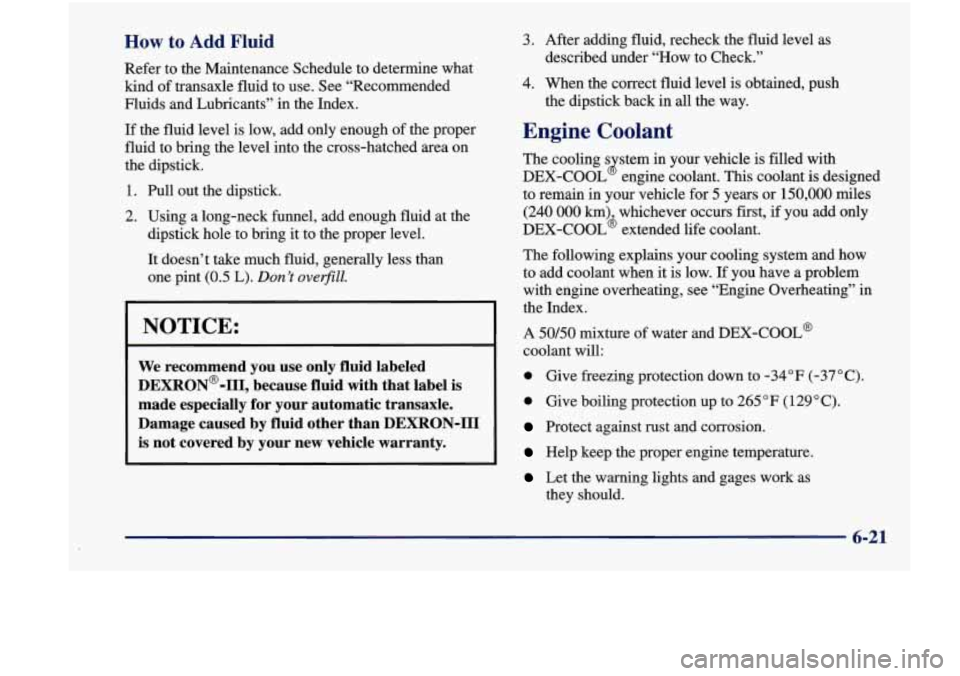
How to Add Fluid
Refer to the Maintenance Schedule to determine what
kind of transaxle fluid to use. See “Recommended
Fluids and Lubricants” in the Index.
If the fluid level is low, add only enough of the proper
fluid to bring the level into the cross-hatched area on
the dipstick.
1. Pull out the dipstick.
2. Using a long-neck hnnel, add enough fluid at the
dipstick hole to bring
it to the proper level.
3. After adding fluid, recheck the fluid level as
described under “How to Check.”
4. When the correct fluid level is obtained, push
the dipstick back in all the way.
Engine Coolant
The cooling s stem in your vehicle is filled with
DEX-COOL engine coolant.
This coolant is designed
to remain in your vehicle for 5 years or
150,000 miles
(240 000 km) whichever occurs first, if you add only
DEX-COOL’ extended life coolant.
B
It doesn’t take much fluid, generally less than The following explains your cooling system and how
one pint
(0.5 L). Don’t oveflZZ. to add coolant when it is low. If you have a problem
with engine overheating, see “Engine Overheating” in
I 3 the Index.
NOTICE: A 50/50 mixture of water and DEX-COOL@
coolant will:
We recommend you use only fluid labeled
DEXRON@-III, because fluid with that label is
made especially for your automatic transaxle.
is not covered by your new vehicle warranty.
Protect against rust and corrosion. Damage caused by fluid other than DEXRON-III
a Give boiling protection up to 265 “F (129 “C).
a Give freezing protection down to -34°F (-37°C).
Help keep the proper engine temperature. z
Let the warning lights and gages work as
they should.
6-21
Page 283 of 356
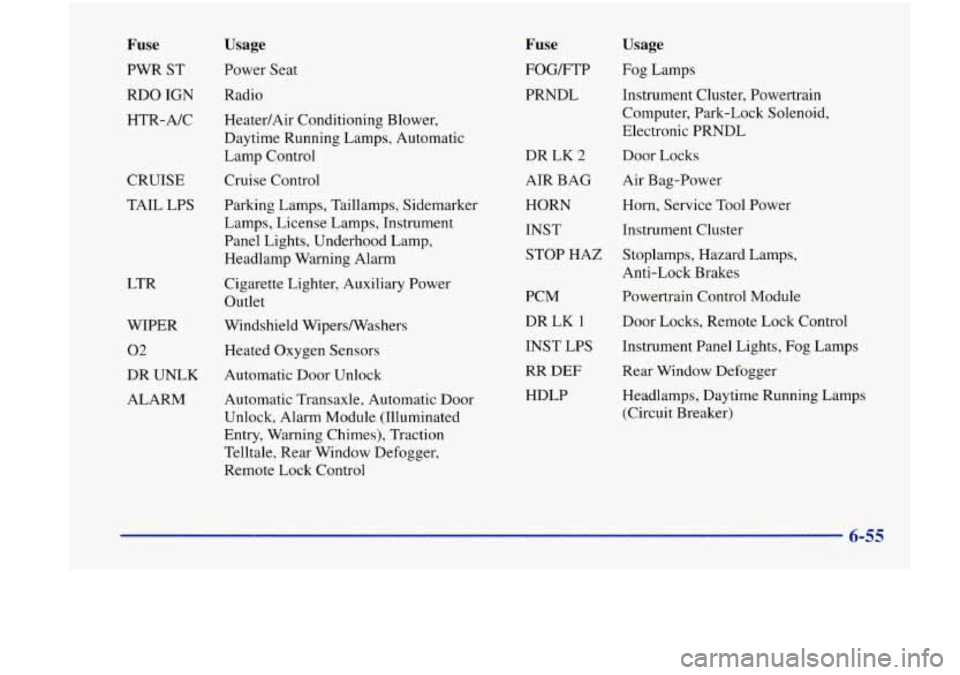
Fuse
PWR ST
RDO IGN
HTR-A/C
CRUISE
TAIL LPS
LTR
WIPER
Usage
Power Seat
Radio
Heater/Air Conditioning Blower,
Daytime Running Lamps, Automatic
Lamp Control
Cruise Control
Parking Lamps, Taillamps, Sidemarker
Lamps, License Lamps, Instrument
Panel Lights, Underhood Lamp,
Headlamp Warning Alarm
Cigarette Lighter, Auxiliary Power
Outlet
Windshield Wipers/Washers
02 Heated Oxygen Sensors
DR UNLK Automatic Door Unlock
ALARM Automatic Transaxle, Automatic Door
Unlock, Alarm Module (Illuminated
Entry, Warning Chimes), Traction Telltale, Rear Window Defogger,
Remote Lock Control
Fuse
FOGLFTP
PRNDL
DR LK
2
AIR BAG
HORN
Usage
Fog Lamps
Instrument Cluster, Powertrain
Computer, Park-Lock Solenoid,
Electronic PRNDL
Door Locks
Air Bag-Power
Horn, Service Tool Power
INST Instrument Cluster
STOP HAZ Stoplamps, Hazard Lamps,
Anti-Lock Brakes
PCM
DR LK 1
INST LPS
RR DEF
HDLP
Powertrain Control Module
Door Locks, Remote Lock Control
Instrument Panel Lights, Fog Lamps
Rear Window Defogger
Headlamps, Daytime Running Lamps (Circuit Breaker)
6-55
Page 347 of 356

Headlamps .................................... 2-37
Bulb Replacement
............................ 6-32
High/Low Beam Changer
...................... 2-31
OnReminder
................................ 2-38
Wiring
..................................... 6-53
Heating
........................................ 3-3
Highway Hypnosis
.............................. 4-23
Hill and Mountain Roads
......................... 4-23
Hitches. Trailer
................................. 4-36
Hood Checking Things Under
......................... 6-8
Release
...................................... 6-9
Hydroplaning
.................................. 4-19
Hearing Impaired. Customer Assistance
.............. 8-4
High-Beam Headlamps
.......................... 2-3 1
Ho~ ......................................... 2-29
If a Tire Goes Flat
.............................. 5-24
Ignition Positions
............................... 2- 13
Transaxle Lock Check
......................... 7-33
Illuminated EntryExit System
..................... 2-40
Inflation. Tire
.................................. 6-37
Inside Daymight Rearview Mirror
................. 2-42
Inspections Brakesystem
................................ 7-35
Exhaust Systems
............................. 7-34
Front-Wheel-Drive Axle Boot
.................. 7-34
Front-Wheel-Drive Axle Seal
................... 7-34
Radiator and Heater Hose
...................... 7-34
Steering
.................................... 7-34
Caliper/Knuckle Maintenance
................... 7-34 Suspension
.................................. 7-34
Throttle Linkage
.............................. 7-34
Instrument Panel
............................... 2-46
Brightness Control
............................ 2-39
Cleaning
.................................... 6-46
Cluster
..................................... 2-48
FuseBlock
.................................. 6-54
Interior Lamps
................................. 2-39
Jack. Tire
.................................... 5-26
Jumpstarting
................................... 5-3
Key Lock Cylinders Service ..................... 7-31
Keys
.......................................... 2-2
Labels Certification
................................. 4-31
Service Parts Identification
..................... 6-52
Tire-Loading Information
...................... 4-31
Vehicle Identification Number
................... 6-52
Lamps
........................................ 2-37
Exterior
.................................... 2-37
Interior
..................................... 2-39
OnReminder
................................ 2-38
Leaving Your Vehicle
............................. 2-6
Leaving Your Vehicle with the Engine Running
....... 2-25
Lighter
....................................... 2-44
Lights Air Bag Readiness
............................ 1-23
Anti-Lock Brake System Warning
............ 2.53, 4.7
9-5